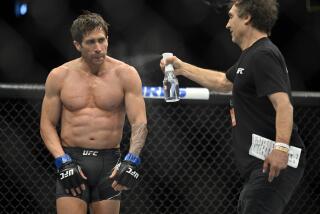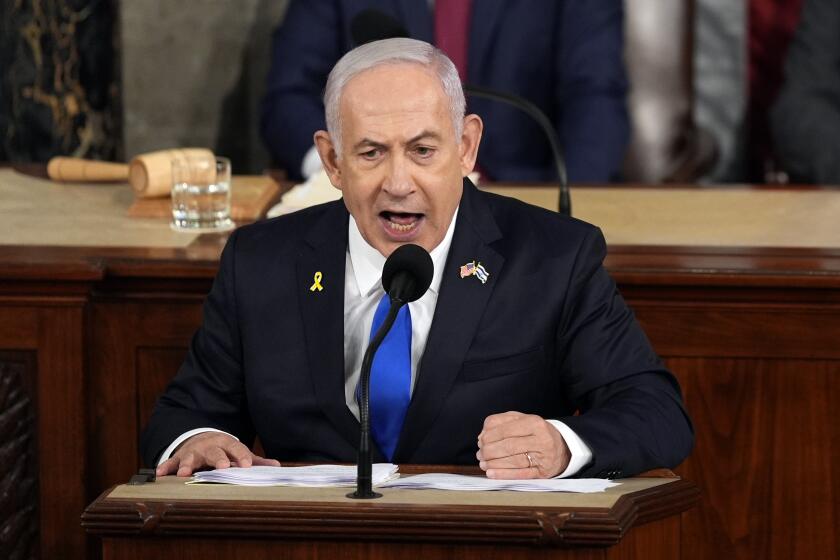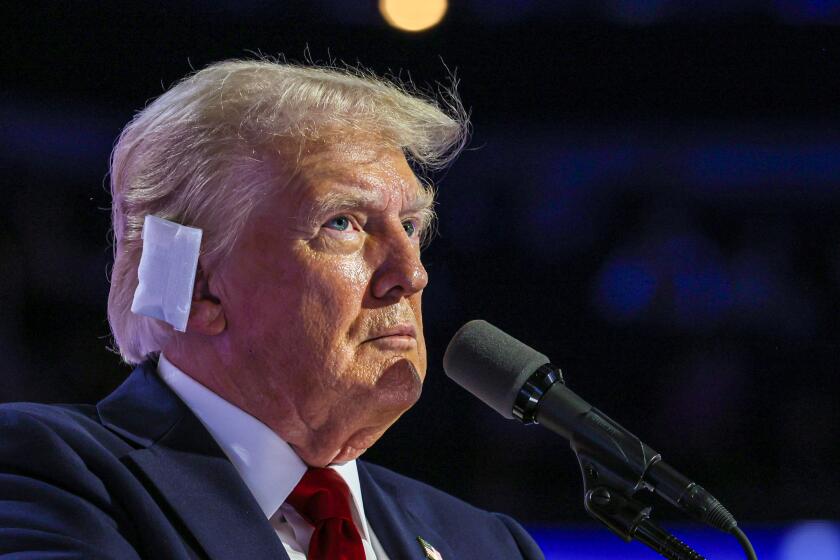Opinion: The ‘Hollywood Circuit’ hands a win to filmmakers over actors
The 9th Circuit Court of Appeals backed away from the controversial copyright-law ruling that then-Chief Judge Alex Kozinski had authored last year, finding that an actress in a notorious movie about the Muslim prophet Muhammad did not hold a copyright over her five-second appearance in the movie’s trailer.
The en banc ruling aligns the court with the U.S. Copyright Office, which said actress Cindy Lee Garcia did not hold a copyright over her fleeting appearance. It also adds weight to the argument, advanced by this newspaper and other news organizations, that copyright law shouldn’t be used for the sole purpose of restraining speech.
And though the ruling isn’t likely to shake up Hollywood, it was a clear victory for filmmakers over the actors’ unions.
Writing for the court’s majority, Circuit Judge M. Margaret McKeown expressed sympathy for Garcia, who says she has received death threats after being tricked by the filmmaker to perform in an inflammatory film. But Garcia has other ways to seek relief that don’t require her to assert a copyright over the clip, McKeown wrote.
According to court documents, Garcia was hired for a small role in a movie titled “Desert Warrior,” which was supposedly an adventure movie set in ancient times. She had two lines -- “Is George crazy? Our daughter is but a child?” -- that she was told to deliver with a concerned look on her face. She earned $500 for about 3 1/2 days’ work.
Later, she discovered that she’d been “bamboozled,” McKeown wrote. The filmmaker, Mark Bassley Youssef, was actually putting together an “anti-Muslim polemic” titled “Innocence of Muslims,” which depicted Muhammad as evil and depraved. Youssef (also known as Sam Bacile) distributed a nearly 14-minute trailer for the film on YouTube in 2012, in which Garcia appeared briefly. Her original lines had been cut and a new one dubbed in by another speaker, who asked, “Is your Muhammad a child molester?”
The trailer caused an international sensation -- and not in a good way. Violent protests erupted in the Middle East, and an Egyptian cleric called on Muslims to kill the filmmaker, the actors and anyone else who helped make the movie. Hence the death threats directed at Garcia.
The actress initially asked a California Superior Court judge to order Google (which owns YouTube) to take down the trailer, to no avail. She then asked a U.S. District Court judge for an injunction against Google, claiming that her copyrights were being violated. The judge disagreed, only to be reversed by a divided three-judge panel on the 9th Circuit.
The panel’s ruling, written by Kozinski, held that “an actor’s performance, when fixed, is copyrightable if it evinces ‘some minimal degree of creativity ... no matter how crude, humble or obvious it might be.’” Kozinski added, “That is true whether the actor speaks, is dubbed over or, like Buster Keaton, performs without any words at all.”
A key factor in Garcia’s case was Youssef’s deception, which Kozinski said nullified the agreement that had given the filmmaker the copyrights to her performance. That’s why she could stop the distribution of a trailer that included her performance, regardless of what Youssef wanted to do with it, Kozinski maintained.
Google appealed to the full 9th Circuit, supported by a host of filmmakers, media and technology companies and opposed by actors’ and musicians’ unions. Google argued that the various components of a movie were not covered by individual copyrights, and the full court agreed.
The film itself is copyrighted, McKeown wrote, as is the script from which it was derived. But Garcia didn’t “author” either of those, at least not in the way the law requires.
Citing the 9th Circuit’s ruling in Aalmuhammed vs. Lee in 2000 (a copyright dispute over Spike Lee’s movie “Malcolm X”), the court’s majority held that a movie was a single copyrightable work, albeit one that might have more than one author. “Garcia’s theory of copyright law would result in the legal morass we warned against in Aalmuhammed — splintering a movie into many different ‘works,’ even in the absence of an independent fixation. Simply put, as Google claimed, it ‘make[s] Swiss cheese of copyrights.’ ”
Preserving (“fixing”) a work in a physical or digital medium is essential to claiming copyrighted authorship, the court held. In this case, Garcia didn’t do that -- Youssef and his crew did, and in the case of her altered role in the trailer, they did so without her authorization.
Wrote McKeown: “Garcia’s theory can be likened to ‘copyright cherry picking,’ which would enable any contributor from a costume designer down to an extra or best boy to claim copyright in random bits and pieces of a unitary motion picture without satisfying the requirements of the Copyright Act.”
In their brief in support of Garcia, the actors’ and musicians’ unions had argued that even a short performance was independently copyrightable, provided that it was sufficiently original. Because of the industry’s standard business practices, the copyright over that performance would be held in almost every case by the filmmaker as part of an integrated work, or by the performers and the filmmaker jointly, the unions said. Nevertheless, they argued, the court should leave open the possibility that, in rare occasions, performers may retain control over the copyrights for their scenes.
McKeown’s ruling, which was signed by nine of the court’s 11 judges, leaves little room for such maneuvering. Instead, in the court’s view, there’s a single copyright that covers all parts of a film, and it’s held by the filmmaker individually or jointly with others whose contributions were significant enough to make them joint authors.
In an impassioned dissent, Kozinski argued that the majority was putting a new and dangerous spin on fundamental copyright principles.
“If Garcia’s scene is not a [copyrightable] work, then every take of every scene of, say, ‘Lord of the Rings’ is not a work, and thus not protected by copyright, unless and until the clips become part of the final movie,” Kozinski wrote. “If some dastardly crew member were to run off with a copy of the Battle of Morannon, the dastard would be free to display it for profit until it was made part of the final movie. And, of course, the take-outs, the alternative scenes, the special effects never used, all of those things would be fair game because none of these things would be ‘works’ under the majority’s definition.”
McKeown’s opinion, though, didn’t cast doubt on who holds the copyrights to works in progress, or to scenes that are filmed but not officially released. Those rights would presumably be held by whomever held the copyrights to the overall work. The question the majority addressed is whether performers could assert copyrights over a portion of the larger release, particularly when it was edited in a way that altered their performance.
Jack Lerner, a law professor at UC Irvine who represented a group of documentarians that supported Google’s position, said the position taken by Garcia and Kozinski was “utterly terrifying” to his clients. “We’d have a massive chill on creativity if you had to get a piece of paper from every person who appeared in a film” assigning their copyrights to the filmmaker, Lerner said in an interview Monday.
“Subjects of films recant, regret, want to walk back” the agreements they make, Lerner added. For example, he pointed to the documentary “Queen of Versailles,” whose subjects signed written agreements with the filmmaker, then turned around and sued for defamation. An arbitrator eventually sided with the filmmaker.
As for Garcia’s claims that her safety was in danger, McKeown wrote that a copyright lawsuit wasn’t the right answer. After all, she wrote, the whole point of copyrights is to encourage public access to an author’s creative works.
“Privacy laws, not copyright, may offer remedies tailored to Garcia’s personal and reputational harms,” the judge added. “On that point, we offer no substantive view. Ultimately, Garcia would like to have her connection to the film forgotten and stripped from YouTube. Unfortunately for Garcia, such a ‘right to be forgotten,’ although recently affirmed by the Court of Justice for the European Union, is not recognized in the United States.”
McKeown was not so sympathetic toward the preliminary injunction that Kozinski had granted against Google.
“The takedown order was unwarranted and incorrect as a matter of law,” McKeown wrote. “It also gave short shrift to the First Amendment values at stake. The mandatory injunction censored and suppressed a politically significant film — based upon a dubious and unprecedented theory of copyright. In so doing, the panel deprived the public of the ability to view firsthand, and judge for themselves, a film at the center of an international uproar.”
In a way, the case is reminiscent of the sampling disputes in the music industry. A very short performance — even just a few notes — can form the basis of a copyright claim. But the claim has to be advanced by the copyright holder, which may be the record label that put out the recording, not the person who played the notes. Had someone else made a copy of Garcia’s work and released it on YouTube, under McKeown’s ruling, there could still be a valid claim of copyright infringement. But it would have to be brought by Youssef, not Garcia.
Follow Healey’s intermittent Twitter feed: @jcahealey
More to Read
A cure for the common opinion
Get thought-provoking perspectives with our weekly newsletter.
You may occasionally receive promotional content from the Los Angeles Times.







